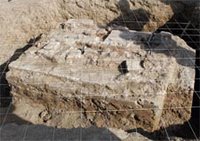Discovery of Parthian Earthenware Floors in Dastva City

Tehran, 6 March 2006 (CHN)- Discovery of an earthenware floor in depth of 25 centimeter in the Sassanid halls in Dastva city surprised archaeologists. In addition, two other pillars were discovered in the Sassanid hall in Dastva historical city in Shushtar in Khuzestan province.
“In 25 meters depth of one on this pillars an earthenware floor were discovered. Although, some flag stoned floors had already been discovered, this is the first time an earthenware floor has been unearthed in an historical site in Iran. The architectural style of the discovered pillars indicated that most probably it must have been constructed during the Sassanid era, however it seems that the earthenware floor belonged to the Elamite-Parthian era,” said Mehdi Rahbar, archaeologists and head of excavation team in Dastva city.
Last season of archeological excavations in Dastva historical site led to the discovery of a 2000-year-old plaster window belonging to the Parthian-Elamite era and some unique stucco decorations for the first time in this historical site. Dastva city was established on the basin of Gargar River (the ancient name for Karun River) during the first century AD during the Elamite Period. This historical city was inhabited until the 9th and 10th centuries AD, and then little by little it was abandoned.
There were different local governments in this region some 2000 years ago; each of them functioned like an independent country. Sometimes the local rulers were allied and sometimes they came into clash with one another. The remained historical sites from that period indicate that the inhabitants of these regions enjoyed a comprehensive urban system contemporary with the Seleucids period (320-141 BC).

0 Comments:
Post a Comment
<< Home